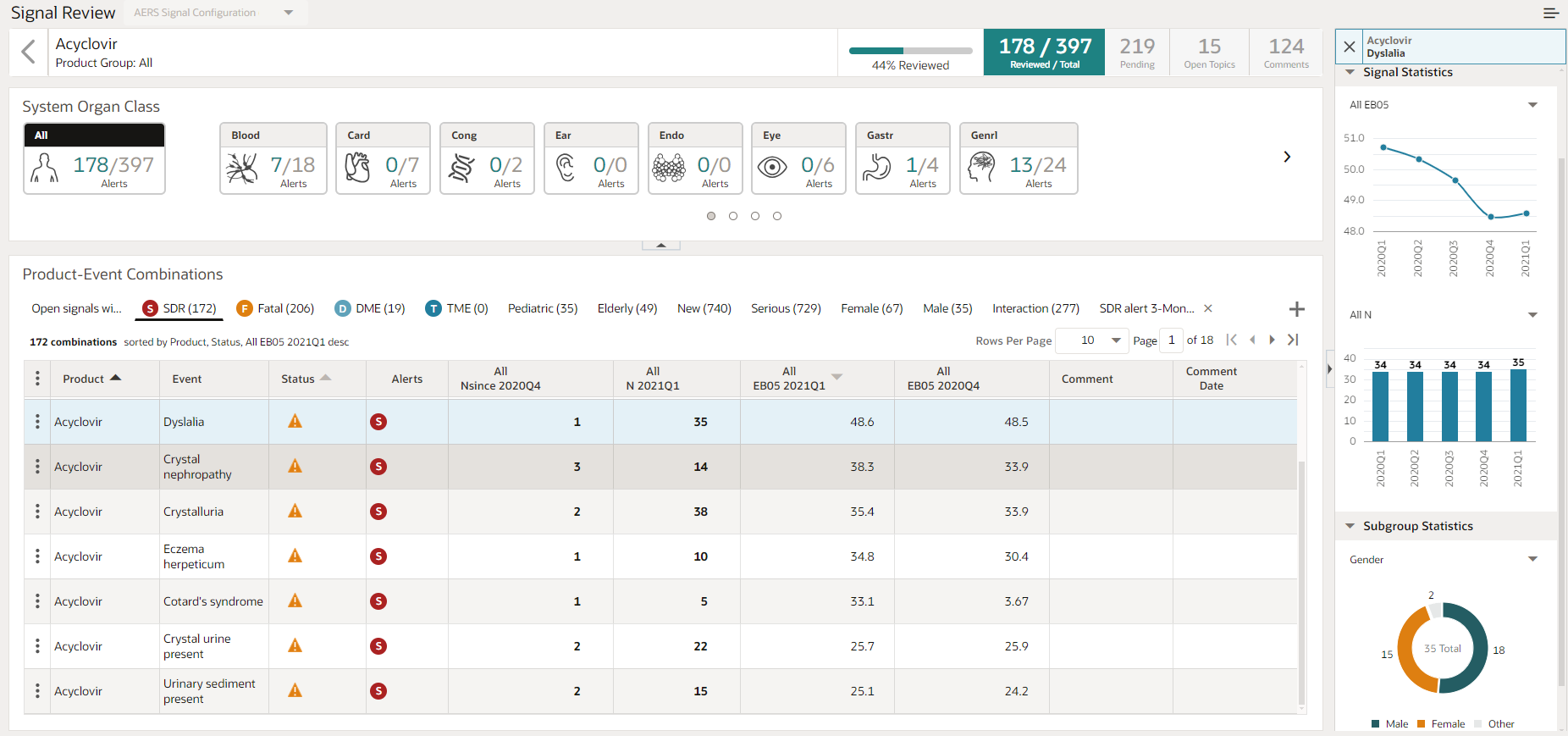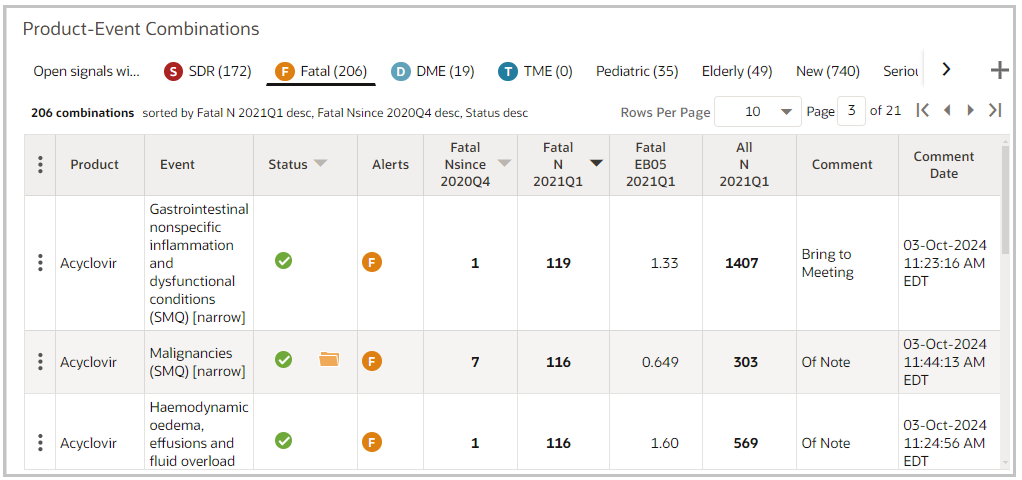Start with the Product-Event Combinations page
On the Product-Event Combinations page, you can review comprehensive product-event information and statistics for a single or multiple products.
You access the Product-Event Combinations page from the Products page by selecting one or more products.
Figure 2-6 Product-Event Combinations page

Product Summary information (across the top): Product statistics appear here with the product name and Products By group, product group, percentage reviewed gauge, count of reviewed/total tracked alerts, the number of pending (unreviewed) alerts, product-event combinations associated with open topics (available if the signal configuration is integrated with Topics), and count of product-event combinations with comments.
Figure 2-7 Product Summary information

Note:
In Select Rows mode with multiple products selected, the summary includes the names of the selected products and the statistics includes the counts for all the selected products.Figure 2-8 System Organ Class (SOC) cards

Note:
If you select an SOC card while in Select Rows mode with multiple product-event combinations selected you will exit Select Rows mode.Product-Event Combinations panel and tabs: The Product-Event Combinations panel is a set of tables. When investigating a single product, there is a tab above the table for each active alert type. Selecting a tab changes the content of the Product-Event Combinations table. Because alert tabs are based on a particular review for a single product, you won't see alert tabs when you initially access a Product-Event combinations table for multiple products. However, you can add tabs and views to that table.
Figure 2-9 Product-Event Combinations panel and tabs

Each Product-Event Combinations tab is associated with a view or alert type rule. The view or alert type rule determines the columns, rows, and sort order of the tab’s table. As you select a tab, a summary line appears below the row of tabs showing the number of combinations, the sort order, the number of rows per page, and the page number. You can add tabs, change pages, and customize the columns.
Columns and cells:
- If the configuration is multisource, there can be columns for the Lead and Secondary configurations.
- The Status column indicates if the product-event combination has been reviewed and if there is a topic for the product-event combination.
- The Alerts column indicates which tracked alerts relate to the product-event combination in the most recent refresh. The icon color and letter were set up when the alert type was created and match the icons in the tabs. In the example above, F stands for Fatal and D for Designated Medical Event.
- Click the hyperlinked (bold) value in a cell to display a menu
to drill down to case-specific information. Menu items include:
- View Cases
- Create Case Series
- Transfer to Case Series
- Download Cases
- Download Case Details
- Reports to view a list of reports about cases and generate a report.
Detail panel: The Detail panel on the right graphically depicts Recent History, Signal Statistics, Subgroup Statistics, and Associated topics for the selected product-event combination. Topics appear only if your configuration is integrated with Oracle Empirica Topics.
Figure 2-10 Detail panel

You can select different variables to graph, such as All EB05, Age Group, or
Gender, using the drop-down lists in the Signal Statistics or Subgroup Statistics
sections. To perform further actions on the data associated with a bar or donuts slice,
click the bar or slice to display the Action menu. You can select View
Cases or other actions related to case series and reports. You can show
(![]() ) or hide (
) or hide (![]() ) the sections in the Detail panel. If you add a comment or change the
associated topic information, the panel updates.
) the sections in the Detail panel. If you add a comment or change the
associated topic information, the panel updates.
The Detail panel header displays the Product-Event name and indicates if the event is a Listed, TME, DME, or IME event.
- Recent History: Displays the most recent product-event alert and comment information plus up to two other rows of alert and comment information. It also includes a link to the Signal History page.
- Signal Statistics: Displays two graphs: a line graph for the chosen statistic and a bar graph for the chosen count. You can update the graph by selecting a different statistic, count, or subgroup. If you are working with a multisource signal configuration, statistics from lead and secondary configurations are available. You can drill down to cases and generate reports from the bars in the bar chart.
- Subgroup Statistics: Displays a doughnut chart of case counts for a subgroup, such as a Gender. You can update the graph by selecting a different subgroup. If you are working with a multisource signal configuration, statistics from the lead and secondary configurations are available. You can drill down to cases and generate reports from the sections of the pie chart.
- Associated Topic: Displays information about a topic if
associated with the product-event combination, including counts of open and
overdue actions. Click
 to view the topic in the Topic Viewer.
to view the topic in the Topic Viewer.
Actions you can perform on the Product-Event Combinations table include:
- View product-event combinations for a card or tab
Use cards and tabs to choose the specific data to display on the product-event combinations table. - Configure columns for the product-event combinations table
Signal summary columns appear on the product-event combinations table. When Signal management is set up for your organization, you can edit the column labels, descriptions, and tooltips for the table. - Limit the product-event combinations to a specific alert type
You can limit the Product-Event Combinations table to a specific alert type by clicking a tab above the table. - Add a tab to the Product-Event Combinations panel
Use tabs to choose the specific data to display on the product-event combinations table. - Create a new view in the Add tab menu
Save your table configurations for easy access. - Apply actions to multiple rows with Select Rows mode
Apply actions to multiple Product-Event Combinations table rows simultaneously. - Product-event combination statistics
Learn about the statistical scores for product-event combinations.